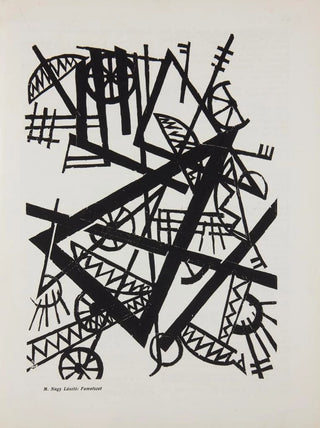Art print | Fametszet - László Moholy-Nagy


View from behind

Frame (optional)
Art print Fametszet - László Moholy-Nagy – Captivating introduction
The work "Fametszet" by László Moholy-Nagy presents itself as a true invitation to delve into the complex and fascinating universe of modern art. This artist, an iconic figure of the Bauhaus, masterfully combines technical innovation with aesthetic exploration, creating pieces that challenge our perception of the world. "Fametszet" is a perfect example of this approach, where light, form, and color come together to offer a unique visual experience. Contemplating this work, the viewer is transported into a dialogue between abstraction and reality, a duality that characterizes Moholy-Nagy's oeuvre and continues to inspire contemporary artists.
Style and uniqueness of the work
The style of "Fametszet" is distinguished by its boldness and modernity. Moholy-Nagy employs dynamic lines and geometric shapes that seem to move across the canvas, creating a sense of motion and vitality. The composition is carefully orchestrated, with each element occupying its place within a delicate balance between chaos and harmony. The contrasts of light and shadow, along with subtle nuances of color, add depth that invites meticulous exploration. The piece transcends mere visual appeal to become a sensory experience, where the viewer's gaze is constantly drawn and redirected, revealing unexpected details with each observation. This innovative approach makes "Fametszet" a centerpiece, emblematic of Moholy-Nagy's creative genius.
The artist and his influence
László Moholy-Nagy, born in 1895 in Hungary, is a central figure of the Bauhaus movement, an artistic current that revolutionized art and design in the 20th century. His work is not limited to painting; it encompasses photography, graphic design, and even architecture, demonstrating his versatility and avant-garde spirit. Moholy-Nagy firmly believed in the power of art to transform society and improve daily life. His influence is still felt today, not only in the field of visual arts but also in industrial design and photography. The principles he established continue to inspire

Matte finish

View from behind

Frame (optional)
Art print Fametszet - László Moholy-Nagy – Captivating introduction
The work "Fametszet" by László Moholy-Nagy presents itself as a true invitation to delve into the complex and fascinating universe of modern art. This artist, an iconic figure of the Bauhaus, masterfully combines technical innovation with aesthetic exploration, creating pieces that challenge our perception of the world. "Fametszet" is a perfect example of this approach, where light, form, and color come together to offer a unique visual experience. Contemplating this work, the viewer is transported into a dialogue between abstraction and reality, a duality that characterizes Moholy-Nagy's oeuvre and continues to inspire contemporary artists.
Style and uniqueness of the work
The style of "Fametszet" is distinguished by its boldness and modernity. Moholy-Nagy employs dynamic lines and geometric shapes that seem to move across the canvas, creating a sense of motion and vitality. The composition is carefully orchestrated, with each element occupying its place within a delicate balance between chaos and harmony. The contrasts of light and shadow, along with subtle nuances of color, add depth that invites meticulous exploration. The piece transcends mere visual appeal to become a sensory experience, where the viewer's gaze is constantly drawn and redirected, revealing unexpected details with each observation. This innovative approach makes "Fametszet" a centerpiece, emblematic of Moholy-Nagy's creative genius.
The artist and his influence
László Moholy-Nagy, born in 1895 in Hungary, is a central figure of the Bauhaus movement, an artistic current that revolutionized art and design in the 20th century. His work is not limited to painting; it encompasses photography, graphic design, and even architecture, demonstrating his versatility and avant-garde spirit. Moholy-Nagy firmly believed in the power of art to transform society and improve daily life. His influence is still felt today, not only in the field of visual arts but also in industrial design and photography. The principles he established continue to inspire






